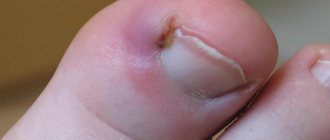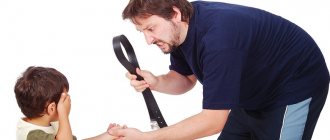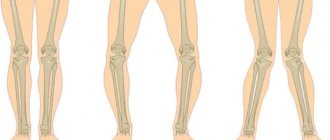An increase in body temperature in children with influenza, acute respiratory viral infections, and colds is quite common. This suggests that the immune system has begun to actively resist viruses that have entered the body.
However, if a high temperature is accompanied by pale skin and cold extremities, this becomes a dangerous symptom. In medicine, there is the concept of “white fever in a child.” We will talk about her.
Concept and features
In medicine, fever is usually divided into white and pink , depending on the color of the skin when the temperature rises.
We can talk about white fever if the so-called white mark is noticeable.
This means that when pressure is applied to the skin, a white spot remains for a long time . This phenomenon is due to the fact that blood circulation is disrupted due to severe spasm.
Fever itself is not a disease; it indicates some kind of disease - and it is necessary to fight it. Young children, from 0 to 3 months, are considered more susceptible to white fever.
This condition requires emergency qualified medical care, since failure to take timely measures can cause dire consequences.
Causes
Why does white fever occur in children? In most cases, this is explained by an infection in the baby’s body, often the result of ARVI . But sometimes it is a reaction to injury, burn, swelling, hemorrhage, tumor.
Neurological and emotional stress can cause fever. Severe pain can also cause this condition.
5 main causes of white fever in children:
- Acute period of infectious lesion.
- Viral infection, the first day of common respiratory diseases.
- Incorrect treatment of bacterial infection.
- A harbinger of many inflammatory diseases - otitis media, pneumonia, as well as pharyngitis, rhinitis, tonsillitis, etc.
- Acute and chronic somatic diseases.
Fever in babies is very dangerous - a convulsive syndrome is possible, as a reaction to the still imperfect mechanisms of heat exchange processes in the baby’s body.
Therefore, children in this condition are urgently hospitalized, and treated and observed in the hospital.
What diseases does it accompany?
As already mentioned, this can be respiratory infections of the upper respiratory tract (upper respiratory tract). Any external attack on the baby’s body can be accompanied by white fever - be it microbial infection, burn or mechanical injury.
Babies cannot yet complain on their own, so if they have a fever, you need to immediately call a doctor - this may also be a harbinger of pneumonia.
The child is not taken to the doctor, but a local pediatrician is called, and maybe an ambulance . The younger the baby, the faster complications develop, so you can’t hesitate.
You will find recommendations for treating viral sore throat in a child on our website.
White fever in a child
Everyone knows that fever performs an important protective function for the body - it helps the immune system fight the invasion of foreign bacteria and viruses. However, some types of fever can be fatal to a child's body. One of these types is white fever. With it, the child has a high fever and cold extremities. If you want to know why this condition develops and how to help your baby, read this article.
Symptoms and signs
It is customary to distinguish three stages, which are distinguished by a strictly defined symptom complex .
Therapy can only be prescribed by a pediatrician.
It all depends on the nature of febrile manifestations in children.
Three stages of fever:
- A sharp rise in temperature in a child.
- Temperature stabilization.
- A sharp drop or slow decline to normal.
In this case, the child has a fever, the blood vessels dilate simultaneously, the skin is pale, the lips turn blue, and breathing is difficult. The baby's feet and palms are cold.
The child is weak and lethargic, there is no appetite . Arrhythmia and dehydration are other dangerous symptoms that require immediate response from adults.
All these symptoms indicate that the body’s immunological system has activated, this is typical for a healthy baby. Such mechanisms contribute to the coagulation effect of a foreign protein.
Urgent Care
What to do?
If the child’s body temperature does not exceed 38.5 degrees, you should not give him an antipyretic. The body will turn on protection, it fights the cause of inflammation.
There is no need to disturb him - in this case, the child should be in a warm, but not hot room. The air in the room should be humidified , the child should not be overheated and not wrapped up. He should drink a lot and eat as desired.
If the temperature jumps higher, you need to give an antipyretic . Although many parents have their own point, after which they decide to lower the temperature.
There are children who feel good even at 39 degrees. Therefore, you can wait until 39-39.2, and only then give the medicine - everything is individual. But if it’s just a baby, any risks are fraught.
Palms and feet need to be warmed up; give the child plenty of warm drinks (water, fruit drinks, raspberry jam with warm water).
Don't feed your baby if he doesn't want to. If all measures do not help, immediately call a doctor.
What to do with red hyperthermia?
Treatment of adults and children occurs according to the following algorithm:
- Cool and plentiful drinks with a slight antipyretic effect. These can be berry fruit drinks and compotes, rosehip decoction, lingonberry or cranberry juices, tea with lemon, etc.;
- If the skin is red, you should not wrap your child in rugs and blankets, even if he complains of being cold;
- The processes of evaporation and release of excess heat can be accelerated by wiping yourself with vinegar diluted with water in a ratio of 3:1;
- Among the physical methods of cooling, we can recommend applying a cloth napkin soaked in cold water to the forehead. It should be changed as often as possible. Bottles filled with cold water should be applied to the location of large vessels, that is, to the neck and groin area;
- If the temperature rises to 39°C, you can start giving an antipyretic, adhering to the age-specific dosage.
The absence of a visible reaction to all actions taken becomes a signal to call an ambulance. They are required to make a lytic mixture themselves, consisting of an antihistamine and an antipyretic drug. After such an injection, a strong increase in temperature is excluded.
Treatment
While the doctor is on his way, give the child something to drink, and you can wipe him with a damp sponge . Be sure to reassure your baby - he may develop chills, muscle pain, he is worried and afraid.
Fear will only worsen the child’s condition, which is why it is so important for parents to be nearby and distract them from worries.
Next, the doctor will prescribe treatment:
- if the cause of the fever is a bacterial infection, the baby will be prescribed antibiotics, but without an antipyretic (it tends to mask the missing results of treatment);
- if an antipyretic is indicated, then the doctor will, in addition to it, prescribe drugs that affect the very cause of the disease ( antivirals , cough and rhinitis remedies, etc.)
If you are a supporter of folk remedies in treatment, be sure to ask your doctor which recipes are optimal in your particular case. So, the baby may benefit from cool or lukewarm baths .
Applying cold compresses can also improve your baby's condition.
Remember raspberry tea. Milk with honey at high temperatures is unacceptable (it curdles in the body).
And it is strictly forbidden - this can cause serious intoxication.
Diagnostics
- With rubella, scarlet fever, meningococcemia, and allergies to antipyretics, fever and rash may appear.
- The causes of a febrile state with catarrhal syndrome are pharyngitis, rhinitis, bacterial inflammation of the middle ear, bronchitis, sinusitis, and severe forms of pneumonia.
- From infectious mononucleosis, viral and streptococcal tonsillitis, scarlet fever, fever with sore throat occurs.
- With laryngitis, obstructive bronchitis, bronchiolitis, inspiratory dyspnea, asthma attacks, fever manifests itself along with difficulty breathing.
- Also, these symptoms are accompanied by manifestations of brain disorders with: encephalitis, febrile convulsions, meningitis.
- Acute intestinal infections are easy to diagnose if there is fever and diarrhea.
- If your child has a fever, stomach pain, or vomiting, you may need to look for a urinary tract infection or appendicitis.
- With rheumatism, arthritis and urticaria, joint damage occurs along with fever.
If the cause of the fever is a serious illness, the child is sleepy, irritable, does not want to take fluids, you observe disturbances of consciousness, hypo-hyperventilation of the lungs - such symptoms require immediate hospitalization in the emergency intensive care unit.
Komarovsky's advice
Pediatrician Komarovsky insists that at high temperatures, parents should be as attentive as possible to the baby - a small percentage of children may develop febrile seizures , which are fraught with disturbances in the functioning of the nervous system.
The famous doctor also mentions dehydration as another dangerous consequence of hyperthermia. Therefore, drinking plenty of fluids at high temperatures is rule No. 1.
are prohibited for hyperthermia
When to lower your temperature
Not every increase in temperature requires medication to reduce it. There are a number of situations in which it is necessary to reduce fever in children:
- If the body temperature rises to 38°C or higher in children under 3 years of age,
- If body temperature rises above 38.5° with any type of fever,
- For pale fever at any reading on the thermometer,
- At a temperature above 38° in children with diseases of the cardiovascular (congenital and acquired defects, heart failure, pathology of the coronary vessels) and nervous system (epilepsy, history of seizures).
It should be noted that not all antipyretics can be given to children. Drugs that should not be given to children:
- Acetylsalicylic acid (Aspirin). This drug can cause Reye's syndrome and also has a pronounced hepatotoxic effect,
- Nimesulide is toxic to the child’s body, has a destructive effect on the liver,
- Analgin in tablet form . It disrupts the process of hematopoiesis. Analgin is approved in emergency cases in the form of injections.
Forecast
If parents act competently, the child is under the supervision of a doctor, the prognosis is favorable . Complications occur when there is a delay in providing assistance or incorrect actions.
If you have given your child an antipyretic, do not despair when half an hour has passed and there are no results .
In the case of white fever, they can only be expected after 2-3 hours.
If the temperature drops to 38, that’s already good; if it drops even half a degree, that’s also a result. There is no need to immediately give the child new medications, this can lead to hypothermia .
Stay in touch with your doctor, don't panic, and don't convey your concerns to your already anxious baby.
What are the symptoms and signs of chickenpox in children? Find out about this from our article.
Choice of antipyretic agent:
It is recommended to use only the following as antipyretic drugs in children:
Paracetamol (Panadol, Calpol, Efferalgan) in children after the 1st month of life in a single dose of 15 mg/kg, daily dose of 60 mg/kg.
Ibuprofen (Nurofen for children) is recommended for children from 3 months of age in conditions with a pronounced inflammatory and pain component in a single dose of 6-10 mg/kg, daily dose of 20-40 mg/kg.
Analgin (metamizole) is prescribed only in emergency cases parenterally (0.1-0.2 ml of 50% solution per 10 kg of body weight intramuscularly only).
Aspirin, analgin (orally), and nimesulide (Nise) should not be prescribed.










